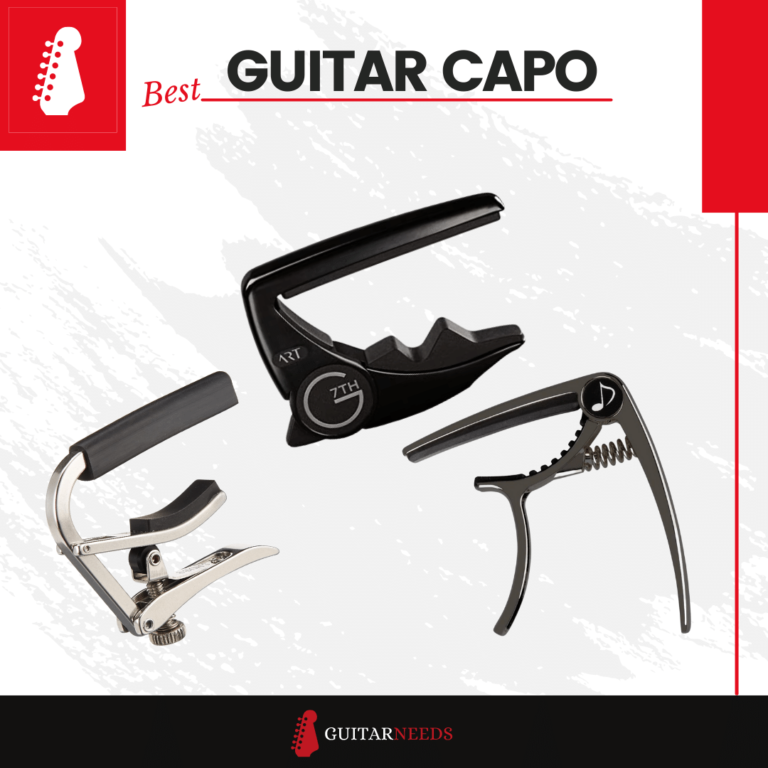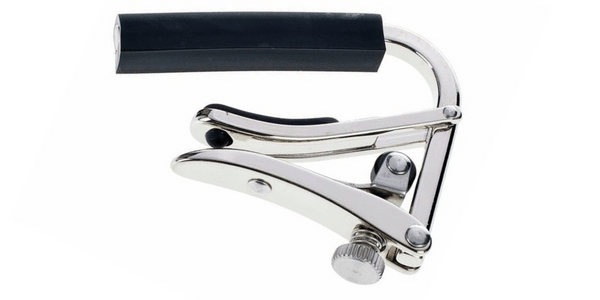This is my review of the best guitar capo for acoustic and electric guitars.
With a capo you can take your creativity on the guitar to great heights. You play the same instrument, but suddenly you experience the fretboard from a different angle and see new possibilities. It makes learning to play guitar easier and gives a lot of fun!
A capo enables guitarists to easily change the key of the guitar. It’s a simple solution: where you would otherwise use your index finger to play a barre chord, you now place the capo on the guitar neck, and can use the same basic chord shapes as in first position. A capo is indispensable for acoustic guitar players. Many beautiful fingerpicking songs require a guitar capo to play them. Singers like to use a capo to quickly change the tuning of a song. Place the capo on a different fretboard position and the problem is solved!
Actually, every guitarist should have a capo in their pocket by default. It is is one of the top accessories for guitarists. This review is going to help you choose a capo that suits you. My list includes capos to fit every budget, style and taste.
Top Picks
- best high-end guitar capo: G7th Performance 3 ART Guitar Capo.
- best premium guitar capo: Shubb S1 Guitar Capo.
- best great value guitar capo: Donner DC-2 Guitar Capo.
Let’s have a look at some of the greatest guitar capos on the market to see which one is ideal for you!
1. G7th Performance 3 ART Guitar Capo
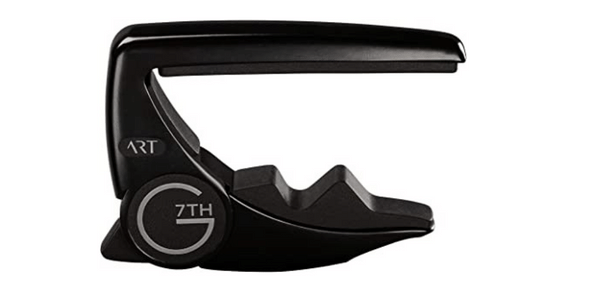
Price indication: $ 35-70
Since its release the G7th Performance 3 ART Guitar Capo has greatly impressed me. It comes with G7th’s Adaptive Radius Technology and can be played with both flat and curved fretboards with just minor tuning adjustments. The brand’s Adaptive Radius Technology is a mechanism inside the top bar that adapts to the shape of your guitar’s fretboard. Do not be alarmed by the rubber pad’s jagged appearance as it hits the back of the neck. It is possible to attach the capo from above or below the neck.
While performing or between songs, clamping it from above makes on-the-fly capo moves simpler and less dangerous (less risk of dropping the capo). The release lever makes unclamping simple, and while playing, the capo can be easily moved. You may conveniently store the capo on the nut of your guitar when not in use since you can exactly manage the clamp pressure.
The Performance 3 is not big or heavy, but it seems sturdy and well-made. The G7th Performance 3 capo is backed by a free lifetime guarantee. The capo is offered in black and 18kt gold plate in addition to a satin silver version.
For
- Suits any fretboard radius.
- Easy to operate, even one-handed.
- Reasonably lightweight and slim.
- Lifetime warranty.
Against
- Not the most affordable capo available.
- May not fit on a 7-string guitar.
2. Shubb S1 Guitar Capo

Price indication: $ 24
Although the Shubb capo uses a clamp, the tension may be changed with a thumb screw. The adjustable screw on the Shubb S1 stainless steel capo ensures perfect and precise tuning at any fret. Because the thumb screw adjustment is employed, the capo also has a tendency to “remember” the tension you previously used. The Shubb is capable of tuning and intonating the guitar at a wide range of frets.
Schubb capos have a similar design to the spring capo, which is a fantastic feature. Using Shubb’s S1’s patented closing action will keep annoying ringers and buzzes at bay. The quality is excellent and these capos are made in the United States. It’s a nice-looking and well-built piece of equipment.
As far as I am concerned these capos are the best. Easy to use, small and compact and very well made. Lasts for YEARS!
For
- Easy to move up and down the neck of your guitar.
- No buzzing of too tight strings because of the soft rubber pad.
Against
- Less suitable for guitars with wider/thicker necks.
3. Donner DC-2 Guitar Capo
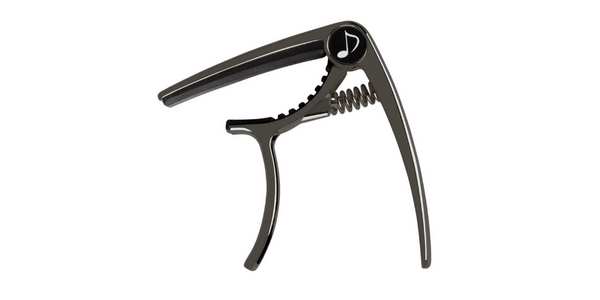
Price indication: $ 8
The Donner DC-2 is a spring-loaded capo that has ‘internal memory to offer strength and fatigue resistance’. It’s a basic spring-loaded capo that can be operated with with one hand and has a loose spring. The Donner capo also functions with a variety of instruments thanks to its half-circle lever (as opposed to a more V-shaped lever).
If you don’t mind installing the capo and tuning to it, it’s a good capo. It is a rock-solid guitar capo with a unique design and superb aircraft-grade zinc alloy construction. The Donner has slightly less padding than some other capos (specifically on the neck lever). Donner is known for offering great value for the money, so anyone on a tight budget would be wise to choose this capo. If you want a capo that looks well, performs well, and is also extremely reasonably priced, this capo is a great choice.
For
- Durable and adaptable to other instruments (for example ukuleles).
- Easy to move.
- Leaves no scratches behind.
- Reasonably priced.
Against
- A little less padding than some other capos.
4. D’addario Planet Waves NS Guitar Capo Pro (CP02)

Price indication: $ 17-20
D’addario’s NS Capo Pro Series capos are the result of an ongoing collaboration between product designer Ned Steinberger, Jim D’Addario and Planet Waves. A patented micrometer adjustment mechanism allows the player to dial in the exact tension needed for clear ringing notes without excessive force in any position on the neck. Minimal mass means the NS Pro doesn’t weigh your guitar’s neck down (a potential concern when capoing at the 1st or 2nd fret) and its miniature size makes for easy fretting beside the capo.
The planet wave Capo is the best smal peace of gear that I have beside my guitar. Easy to mount, quick to change. Very good build quality. The srew head is easy to operate and let you easily adjust the right tension to the strings. So you dont worry abou damaging the neck of your guitars. Now I’ve got 3 more of this genuis tools. I use them with my E-Guitars as well as with my acoustic guitars. Overall I think this is the best value capo you can get.
For
- Ultra-light design.
- FlexFit pad works like your fingers, keeping you in tune.
- Adjustable tension screw makes your guitar sound buzz-free.
Against
- The screw might give you the fear that you put it on too tight. But the sweet spot doesn’t increase much tension in the strings.
- Takes a little longer to change fret than other capos.
5. Ernie Ball Axis Guitar Capo
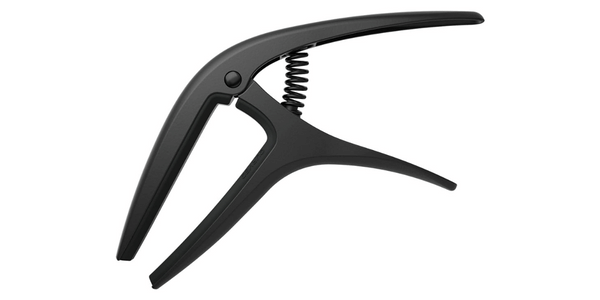
Price indication: $ 13-15
There is no similarity between the Axis capo and the current Axis guitar made by Ernie Ball Music Man. Instead, it’s possible that the term came from the device’s dual-radius design, which is its key selling point.
The Axis has two rubber-padded arms: a flat fretboard arm and a radiused fretboard arm.
Its primary asset is one-handed simplicity of use.
The Axis capo can accommodate a variety of fingerboard shapes. both flat and round. An added feature is that this capo can also be used on seven-string guitars. So all of your guitars will fit with the Ernie Ball Axis capo. No matter the radius of your fretboard, the Axis capo will always make secure, even contact with it thanks to this feature.
The Axis capo shines in terms of use. The spring-controlled, one-handed motion used by Ernie Ball makes it exceedingly simple to clamp on or move to a different fret. Simply switch the capo over to the fretboard-appropriate side you require. Sometimes, simplicity and ease of use triumph over adding too many extra features. The Axis capo performs its function admirably. Te capo is available in four different colours: black, silver, bronze, and gold.
For
- swift one-handed movement.
- Suitable for flat and curved fretboards.
- Works on guitars with six and seven strings.
Against
- Arms might get in the way.
6. Kyser Quick Change Guitar Capo
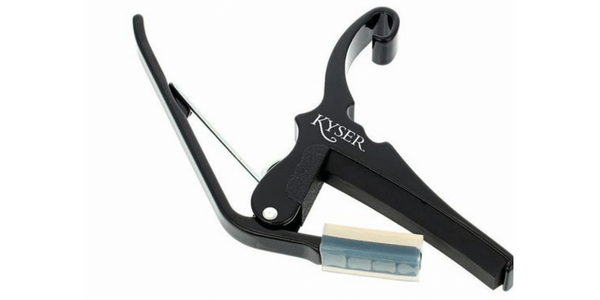
Price indication: $ 17-22
Founded in 1980, Kyser is a trusted name in guitar accessories. Even today, Kyser is one of the most reputable manufacturers of capos, and their initial design was the Quick Change.
The Kyser Quick Change capo is a straightforward spring-based capo and a stylish piece of equipment. The tuning is rather accurate, but like with many capos of a similar design, you will need to practice placing it precisely for the best tune. Although it is quite simple to operate, it requires a firm grip (it is a little tight). It is quite beautifully crafted and appears to have cost much more than it actually did. It has a sturdy appearance and is exquisitely polished, giving it a pleasant sleek appearance and feel. I appreciate the Kyser’s sleek, functional design.
The Kyser employs less material overall and a smaller lever head to clamp onto the bottom of the guitar neck. This allows it to accommodate a wider variety of instruments, such as mandolins, banjos, and ukuleles. It’s produced by hand in the United States and is meant to last a lifetime.
For
- Allows for quick changes.
- Versatile clamp.
- Streamlined.
Against
- A bit heavier than some other capos.
7. Paige Clik Guitar Capo
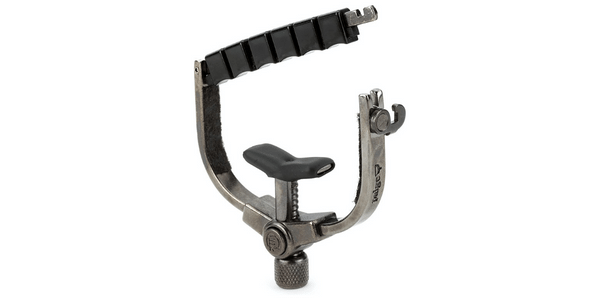
Price indication: $ 70
The revolutionary design of the Paige Clik Guitar Capo boasts a quick-release mechanism that is state-of-the-art. It works well and is simple to use. One-handed adjustment is all you need to achieve the sound you want, and it can be put away when you’re not using it.
The center of gravity is the element that unites all Paige caps and is unique enough to set it apart from other capos. In essence, you clip it on and tighten the screw from the center of the capo’s back. On the other side of the U, the free end of the bar drops down across a small slot, where it curls over the edge and is secured in place by a tiny clasp.
The only drawback is that not everyone will find the design appealing and easy to use. Compared to other capos in this list, the Pagie Clik requires you to hook and unhook the string pad wire to the frame during installation, which is more time-consuming.
It has a sleek appearance and is only as wide as is strictly required. The Paige sits comfortably behind the nut when not in use. Overall, it is an excellent product in every manner.
For
- Will not cause the strings to buzz when pulled from the center instead of sides.
- Controllable tension with precision adjustment.
Against
- The swing bar doesn’t always lock easily.
8. Shubb C1 Guitar Capo
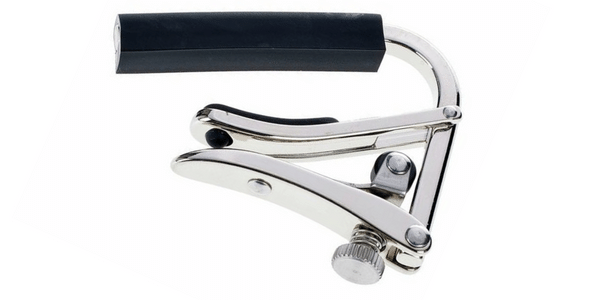
Price indication: $ 16
With the Standard C capos from Shubb you get a premium package for a standard price. This capo can be locked in place or removed by flipping the lever once the screw tension has been adjusted to achieve the desired level of pressure.
A quick-release capo may be preferable if you frequently move your capo around the fretboard or to a different guitar. Due to the fact that most capos mess with your intonation and require constant retuning, this capo uses a soft ruber pad that workst like the tip of your finger. Over-center locking ensures unrivaled easy of use, thanks to its patented design. With its fingertip-like rubber pad and hand-like closing action, this capo will not pull your guitar’s strings out of tune, requiring no retuning. The Shubb C1 is small, stylish and unobtrusive. The capo is a breeze to use: simply flip a lever to lock it in place and remove it.
I have bought these several times, always fantastic value for money. Quality great, easy to fit/use, does the job. I’m sure more expert players look for something more grand, but for me ‘does what it says on the packet’. Great.
For
- Shape won’t impede playing.
- Made up of nickel-plated brass.
- Unobtrusive, small, and stylish.
- Easy to use, patented over-center locking action.
Against
- Lever/screw is slower than other designs.
- Some people may not like to using this type of capo (lever/screw).
9. Thalia Capos 200 Series
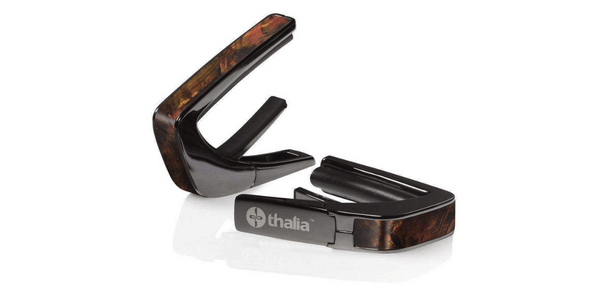
Price indication: $ 75-85
The fret pads on Thalia’s capo are adjusted to the fretboard radius of your instrument. Thalia capos have replaceable pads made for various fretboards. Pads for seven radiuses in both regular and high tension form are provided in fourteen tuning kits. The goal is to eliminate the tuning issues associated with clamp style capos. The capo is rather easy to use, and if you get stuck there is a “quick start guide” to help. If you use the fretpad for multiple guitars, changing the fretpads only takes a few seconds.
For
- Beautiful design.
- Outstanding tune and tonality.
- opportunity for custom styling.
Against
- Some people may prefer an adjustable tension.
10. Dunlop Trigger Capo E-Guitar NI
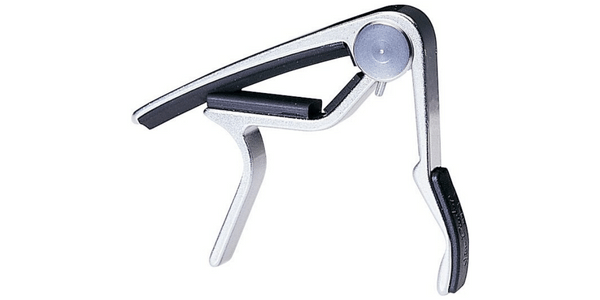
Price indication: $ 24
With the help of the Dunlop Trigger capo, you can play one or more semitones higher without any problems. This device is extremely adaptable and works with both 6-string and 12-string guitars. It is constructed of premium aluminum. It has a powerful spring
that efficiently clamps it in place. Simply clamp this capo behind the desired fret on the neck. Adjusting is very easy with this pleasant-feeling clamp: press (squeeze it like a trigger!), slide and release. It’s a one-handed operation. Easy! Both with 6-string and 12-string guitars, it looks amazing and does an excellent job of keeping the strings tight and pressed against the frets. It is a fantastic capo that’s very reasonably priced and has a long lifespan.
For
- Ease of usage
- You can clamp it to the headstock when not using it
- Five colors, lightweight metal, and a padded handle for ease of usage.
- Robust construction, very durable
Against
- No string tension adjustment
- Pads on the back can come off (not very common, but may happen)
Best Guitar Capo: Buying Advice
Where does the word ‘capo’ come from?
You might think that the word capo is based on the musical term ‘da capo’, which comes from Italian and means ‘from the beginning’. However, capo comes from ‘capodastro’ which is derived from the Italian capotasto. This word means top comb. That is the comb at the head of the guitar neck, where the string begins to sound. An appropriate name, because the capo is actually a kind of movable nut.
What is Fretboard Radius?
Some guitars have a round fretboard, other guitars have a flat fretboard. How round the fretboard is is expressed in the term “fretboard radius. Because a properly functioning capo ideally applies equal pressure to all six (or twelve) strings, there are capos designed specifically for round fretboards and, you guessed it, also capos made specifically for flat fretboards. A third group of capos offer an all-in-one solution and can be customized for more round or flat fretboards.
What types of guitar capos are on the market?
- Capos with straps (“toggle” capos) are relatively inexpensive, but they take more time to attach and you have to use two hands. You can only adjust the tension in steps.
- Capo’s with screw you slide to the desired position after which you tighten them, which works faster than a strap. With the screw, you can accurately determine the desired tension.
- Capo’s with clamp (‘trigger’-capo’s) work like a clothespin, which makes moving them very fast. Extremely handy in live-situations! A disadvantage is that you cannot adjust the tension, so you have the chance that the tension is a bit too high (the strings detune) or too low (the strings rattle). Also, especially on budget models you’ll notice that the spring is subject to wear and tear, which can cause it to lose tension over time.
- Other capos: There are also special capos that combine the advantages of screw and clamp systems. You often pay a bit more, but they offer great functionalities
What guitar capo will work best for my guitar?
The most important point, the fretboard radius, we described above. At the same time, you don’t have to worry too much that it wouldn’t fit: capos are designed to fit just fine on most guitar necks and fretboards. Most capos are also large enough to fit 7-string guitars. In addition, brands usually offer different designs, so you can choose those capos that best fit your guitar. Actually, you should pay particular attention if your guitar has an exceptional neck profile or fretboard shape.
So whether the capo fits your fretboard radius well is your biggest concern. The electric guitar and western guitar both have a convex fretboard, which means that a capo for these instruments should also have a rounded shape. Classical guitars have a flat fingerboard and often a wider nut. If a capo doesn’t fit properly it can send your guitar out of tune. This is the result of too much pressure on the strings, causing them to detune. You can also consider other factors such as ease of use (ergonomics / adjustability), build quality, weight, value for money and last but not least: the looks (design). And of course the capo must be durable and long lasting. So for example no plastic for me!
How to start using a guitar capo?
If you have never used a capo before, practice first by placing the capo on the first, second and third frets. That way you get a first impression of how the guitar sounds with the capo, and get used to positioning the capo properly on the guitar. Place the capo just behind the fret you have it clamped on. Placing the capo in the middle of the fret will distribute the pressure evenly across the guitar neck. If you don’t place the capo correctly you will hear a buzzing or muted sound. To avoid this, place the capo as close to the edge of the fret as possible. Remember to always remove the capo when you are done playing. Leaving the capo on can damage the guitar in the long run. In the short term it will probably put your guitar out of tune.
What’s your favorite guitar capo?
I’d love to hear your experiences. Which capo did you like best and which capo do you think sucks? What do you think of the capos in the above list?
Please leave a comment below and let me know what you think!

